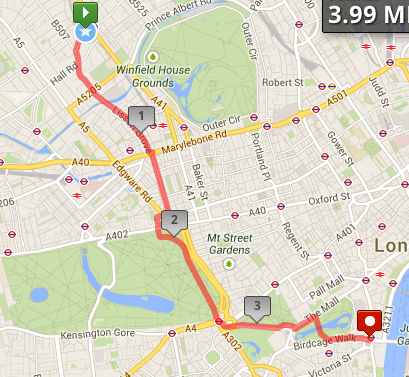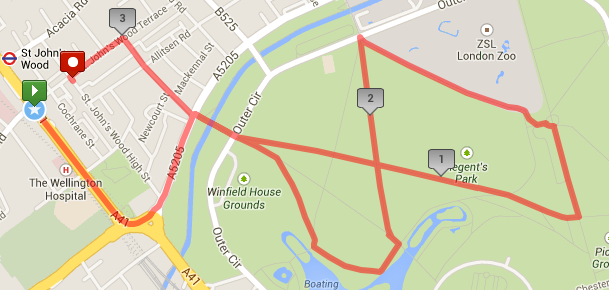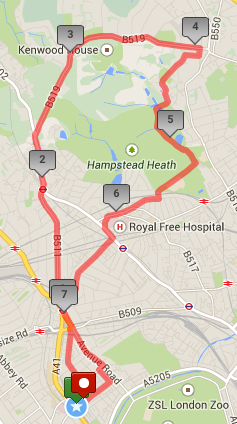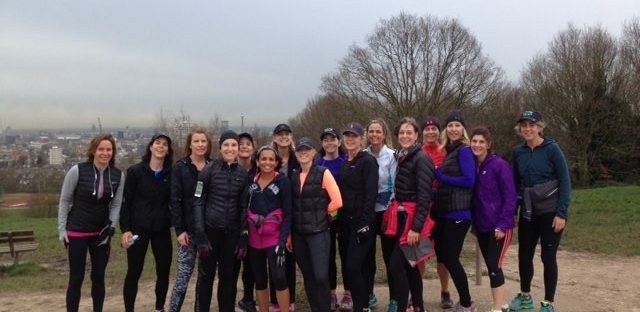Hi Runners,
Our training will continue to pick up as we approach the half marathon. This week our long run is to Big Ben and BACK to St. John’s Wood. Remember when we first ran to Big Ben in the fall? Now we’re making the round trip. (If you’re not quite ready for 8 miles, there is a half way option to go to Big Ben and then stop on the way home at Green Park.) Wednesday we introduce a new tempo training option. Make sure you read the description in the route section. As always, the tempo workouts are more fun if you stick with your group and encourage each other. Friday we’ve added a new 7.5-mile Highgate/Heath route for those who would like to build up to the 8-mile Heath route. It is a good route for us all to learn!
Lastly, some good advice from Dinae –STRETCH! As the mileage goes up and temps come down it is really important to stretch a bit after these long runs before the stop at Starbucks.
As a reminder, our training is based on three runs per week.
-slow, longer run
-fast/tempo run
-hill run
This week I’d like to focus on the importance of running a slower long run. Below I’ve copied Paula’s explanation from our website. This is important stuff so it’s worth the read.
Why do we run the long run slower than race pace?
The quick answer is that it has to do with how your body builds fuel, which is something you’ll need for the race! I’ll delve into the basic science of fueling (which I have hugely over-simplified but hopefully it’ll get my point across). To fuel our runs we have 3 options – Creatine Phosphate (CP), glycogen and fat.
Creatine Phosphate- You have about 15 seconds worth of CP fuel – that’s it. Think Usain Bolt running the 100m – he fuels with CP and it works because he can run 100m in less than 15 seconds. CP is where your body will go first looking for fuel, particularly if you take off like a rocket from Starbucks. Think of CP as kindling on a fire – it catches fire easily but burns out very quickly.
Glycogen- Glycogen is the next fuel option. Glycogen is basically stored in your muscles and in your liver and because of that it makes glycogen a bit more difficult to burn as fuel (think of damp firewood – it will eventually burn but it takes quite a bit to get it going).
Fat- Fat is the 3rd source of fuel and most runners, even the very lean women, have an ample supply of it. Think of fat as a butane tank of gas on the BBQ grill – once it’s lit, you can have countless cook-outs before the fuel is gone.
Here’s the important part- All of those fuel sources – kindling, damp firewood or butane gas need something to ignite them and keep them burning. Physiologically speaking that ignition or burning “tool” is ATP which is created by mitochondria; so, the more mitochondria you have the more efficient you are as a fuel burning machine.
What is mitochondria and how do we get more of it?
Some of us are genetically blessed with higher mitochondria counts. Thank your mother for that – it comes through the maternal side of the genetic equation. If you didn’t win the genetic lottery, then the only way you can increase mitochondria is through LONG, SLOW, ENDURANCE training (LSE). When you go for a long run at a slow pace, you actually produce mitochondria. Kind of cool, huh? Now remember – we need mitochondria to help ignite our fuel sources. So what does that mean for you? It means SLOW DOWN on your long run – give your body a chance to become a mitochondria production factory. If you do your long run at a strong pace, you’re missing out on this benefit.
How slow, is slow?
On our website we have a cool calculator from Runners World that calculates training pace based on your race pace. Pace Link (It has 6 different training paces for speed work, training and longer runs.) If you would like to run the half marathon in 2 hours (which is a fast time) you will need to average 9:10 min/mile during the race but your long run pace should be 10:34-11:54. If you would like to run it in 2 hours and 15 minutes, you will need to run 10:15 min/mile during the race but your long run pace should be 11:46-13:12. If you want to run it in 1 hour and 45 minutes (we will only have a few women at that pace from our group) you will average an 8 min/mile race pace but should do your long run at 9:20-10:30. I think you get the general picture.
But I don’t know my race time?
That’s fine. Talk to the women in your pace group. Many of them will have run a half marathon before and you can get a sense of their race time as a base for what you might target as a race time. During training, if you don’t have a pace watch, ask the women in your pace group so you can get a general sense of the speed of the group. Also, try slowing down to the lower end of your pace group time. As a rule of thumb, your long run should be at a pace so comfortable that you feel like you could run forever.
It feels like this shouldn’t work.
I know it seems counter intuitive. (I want to run a fast race so I train slowly. Really?) Trust us on this one. We’ve had very sceptical runners who followed this program and ran great races. It does work. Also, don’t forget we’ll be adding more tempo and speed work into our workouts, just not on the long run day.
Thanks for reading that long email! And keep running!
Jane
ROUTES
Monday 19 January (8 miles) – Big Ben and back
For this run we head to Hyde Park via the usual route and run along the eastern edge of the park to Hyde Park Corner, under the arch and down Constitution Hill. Run pass the Victoria Memorial down the mall and enter St. James Park. Run over the pond and out of the park, turning left onto Birdcage Walk and down into Parliament Square to Big Ben, then turn around and run the same route back to Starbucks.

Wednesday 21 January — Speed Drills!
Tempo ‘Diamond’ Run
We are continuing with our focused tempo running on Wednesdays. This week we will do ‘diamonds’—they are fast but also fast to be done with so give them a try!
Head over to Regents Park, the normal way. Enter the Park at the Charlbert Entrance and veer to the left path. When you reach the first intersection with the other sidewalk, it is time to turn on your running jets. You will run hard for 1 minute, then recover by running slowly for 3 minutes; then run hard for 2 minutes and recover by running slowly for 3 minutes; then run hard for 3 minutes, recover run slowly for 3 minutes; run hard for 2 minutes, recover run slowly for 3 minutes and finally run hard for 1 minutes, recover run slowly for 3 minutes.
The ‘diamond’ looks like this:
1 minute hard 3 minutes jogging recovery
2 minutes hard 3 minutes jogging recovery
3 minutes hard 3 minutes jogging recovery
2 minutes hard 3 minutes jogging recovery
1 minute hard 3 minutes jogging recovery
If you need to extend the amount of time for the jogging recovery, that’s fine, you can jog up to twice the amount of the hard run time [so 6 minutes max recovery jog for the 3 min hard run]
This type of running is best down within the park so you don’t have to contend with driveways etc. If you find you need more mileage in Regents Park, just keep looping however you see fit.

Friday 23 January – Highgate or The Heath
Today is hill day and you can pick your choice of the Heath Runs. Want to try a new hill run that front loads the hills [almost all downhill after the half way point] and avoids the muddy Heath? Try the Highgate option, below.
Highgate (7.5+miles)
Head up Fitzjohn’s, as usual, and continue past the Hampstead Tube and Whitestone Pond to stay on Spaniards Road. Do not enter the Heath at the normal entry point, but stay on Spaniards Road as it wraps around the outside of the Heath, past Kenwood House and past The Bishops Road where Spaniards Road turns into Hampstead Lane.
Continue on Hampstead Lane as it edges around the outside of the Heath in a gentle rise until you reach The Grove, where you turn right. [The Grove is a pretty, tree lined street just before the Highgate roundabout]. Run to the first right lane, which is Fitzroy Park and has a traffic barrier across the road.] Pass around the traffic barrier—this is fine! And continue down the road, past lovely homes and a famous allotment on the right side. This road curves downhill to the left and takes you to the entrance of the Heath near a set of bathrooms [and just before Merton Lane to the left].
Enter the Heath, run past the loos and take the path to the left as it runs along a the model boating pond, the men’s bathing pond and a third pond. When the sidewalk dead ends, take a right to run along the exercise fields, track and swimming pool. Exit the Heath past the swimming pool, crossing over the bridge onto Constantine Road. Take a right, running past South End Rd/Fleet Rd, past the Royal Free Hospital and cutting to the left just past the Royal Free’s entrance driveway to take a short cut to Haverstock Hill. Go left on Haverstock Hill to Belsize Avenue, veering to the left to stay onto Buckland Crescent and take this to Fitzjohn’s. Left on Fitzjohn’s to Swiss Cottage, then scoot over to St Johns Wood Park Road and back to Starbucks.

Regular Heath routes (4 – 8 miles):
Click here for maps of all of the Heath routes.
______________________________________
Website: https://womenrunningtheworld.commm
Facebook Group: Women Running The World (request to join)
Email: wrwlondon@gmail.com
